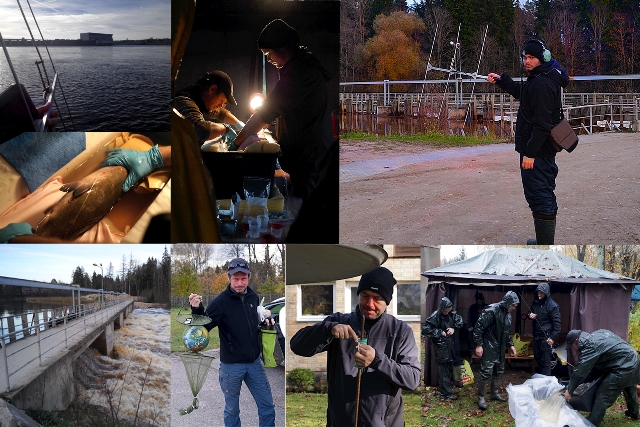Telemetry study in Ogre 2014
Posted by Daniel Nyqvist | InternationalOscar Askling, masterstudent at Karlstad University, reports on the latest progress in Daugava River:
Daugava River is the biggest river in Latvia. It originates at the Valdaja plateau and flows 1020 km through Russia, Belarus and Latvia and empties in to the Gulf of Riga in the Baltic Sea. During the hydropower cascades, from 1938 to 1974; Kegums, Plavinas and Riga Hes were built, which are today producing a great proportion of the total energy production in Latvia. However, the dams affect the longitudinal connectivity, restricting fish migrations. Reductions in fish populations have been reported since the cascade was completed, including the extinction of the sturgeon (Acipenser oxyrinchus) and the blue bream (Ballerus ballerus). In addition, natural reproduction of Atlantic salmon (Salmo salar) does no longer exist, according to the current knowledge. It is impossible for the salmon to pass the first hydropower station Riga Hes near the Daugava river mouth, to reach the historical spawning areas upstream Plavinas Hep. Consequently, fish-stocking was implemented to maintain the fish populations. The hatchery-reared smolts are released downstream Riga Hes, but since they are not tagged it is not possible to differ between farmed and wild fish.
There are still potential spawning areas for Atlantic salmon in the tributary River Ogre, merging with Duagava between Riga Hep and Kegums Hep. The purpose of this study is to see how Atlantic salmon spawners behave when transported upstream past Riga Hep and released in the River Ogre. In theory some of them could explore and spawn in Ogre River. Others may become ”fallbacks”. 17 salmons were tagged subcutaneously with radio transmitters and released upstream a small private-owned hydropower station in Ogre River. The fish were monitored after release using two logger stations (one by River Ogre in a bend upstream Ogre hep, and one at Riga Hep in Daugava) and additional manual tracking. Unfortunately heavy rains caused severe flooding in River Ogre and consequently all spill gates were opened at Ogre dam. The water was very turbid and coloured. From the automatic logger stations we could see that some tagged salmon immediately swam to Riga Hep. During manual tracking we could see that some were stuck in the intake channel of the Ogre Hep, or migrated slowly downstream, eventually reaching Daugava. Some individuals even went upstream Daugava after their visit at Riga Hep, swimming in the turbine outlets of Kegums Hep. The majority of the tagged salmon passed through the Riga Hep turbines to continue downstream.
At this moment we are preparing to tag another group of fish, which hopefully will be released under more ”normal” circumstances. Assuming that the spill gates at Ogre Hep will remain closed, the new fish will not be able to swim downstream past the Ogre Hep and instead they will have no choice but to remain in the Ogre River, and hopefully migrate upstream towards the spawning areas.
For me personally it has been a great adventure being in Latvia, and I’m learning a lot. The people are really nice and helpful in many ways. It is a nice stay!
Best Regards / Oscar Askling



